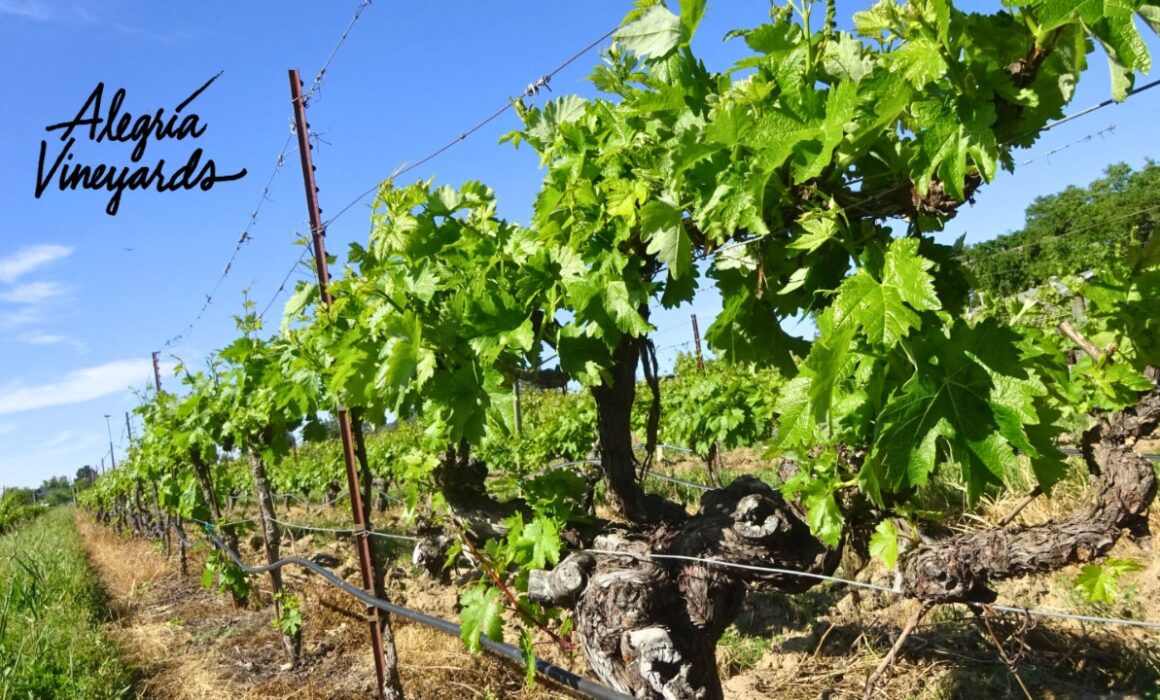One Hundred Wine Varieties and Counting: Sonoma County’s Alegría Vineyards
By Virginie Boone
In 1990, Bill and Betsy Nachbaur bought a century-old vineyard along Sonoma County’s Old Redwood Highway near Healdsburg, knowing it was planted to a field blend of all sorts of grapes like Zinfandel, Alicante Bouschet, Petite Sirah and more, which could trace their roots back to 1890. There was also Sangiovese and Zinfandel growing together put in the ground in 1950.
The couple named the vineyard Alegría, after the word for happiness and joy in both Spanish and Portuguese.
The total expanse of the site is 32 acres, with some of that added to the estate by the Nachbaurs, who put in new plantings in 1991, 1992, 1997 and 2017, including field blends of some of its first whites, Gruner Veltliner and Alvarinho. They also added more Sangiovese and Syrah after seeing both thrive in the older parcels and added Cabernet Franc and Dolcetto.
But what many probably don’t realize is that Alegría’s viticultural diversity is more vast than the entirety of Sonoma County when it comes to the types of grapes growing within the confines of those 32 acres. In fact, there are 108 grape varieties in that dirt, many of them barely in existence in their own home countries let alone the New World.
These include such rarities as Black Monukka from Uzbekistan, a crunchy seedless table grape, and Blaufraenkisch/Limburger from Slovenia. There’s Corinth from Greece , which when dried become known as Zante currants, and Petit Beclan from France, a nearly extinct grape from the Jura, as well as Gros Beclan, also known as Peloursin. Spain’s Palomino and Pedro Ximenez grapes exist here, and Italy’s Canaiolo Nero, Nebbiolo, Sangiovese and Sagrantino.
And so much more, including hybrids from other parts of the United States, like Einsett from New York, created by Cornell University crossing Fredonia and Canner seedless grapes; Suffolk, another seedless red table grape; and Royalty (a red wine grape created by Dr. Harold Olmo at UC Davis in 1938), Rubired (another Olmo hybrid that crosses Tinto Cao and Alicante Ganzin), and Ruby, another seedless, from California.
This is a literal treasure trove of grape varieties. The Nachbaurs trace the vineyard’s original plantings to George and Summers Brumfield whose family settled in Sonoma County in 1852 by way of West Virginia. At one point they owned 850 acres, including present-day Ponzo Vineyards across the highway. Records show they started by growing Zinfandel and Mission grapes, some of the Mission vines still in existence when Betsy and Bill came along in 1990.
A winery was built during the tenure of Elizabeth Moes, between 1896 and 1924. Her daughter Ernestine and son-in-law Adolph DiNucci kept the by-then 40-acre property farmed during Prohibition until 1943. Americo Rafanelli bought it in 1947, adding the plantings of Zinfandel with Sangiovese. A few more owners came afterwards, until that fateful day in 1990 when the Nachbaurs sensed that this Russian River Valley piece of history would be a part of their history too.
Bill and Betsy started out by selling the grapes to such great local producers as Ridge, Rosenblum, Rock Wall and JC Cellars, and continue to sell their grapes today. For three decades they maintained their own wine brand, Acorn Wines, but decided to sell that a few years ago to Ancient Oak Cellars owner Melissa Moholt-Siebert.
Today they remain farmers of this extraordinary viticultural wonderland, with its over 100 varieties, a living lab of historic field blends from all over the world.
Image By: Daniel Mangin


